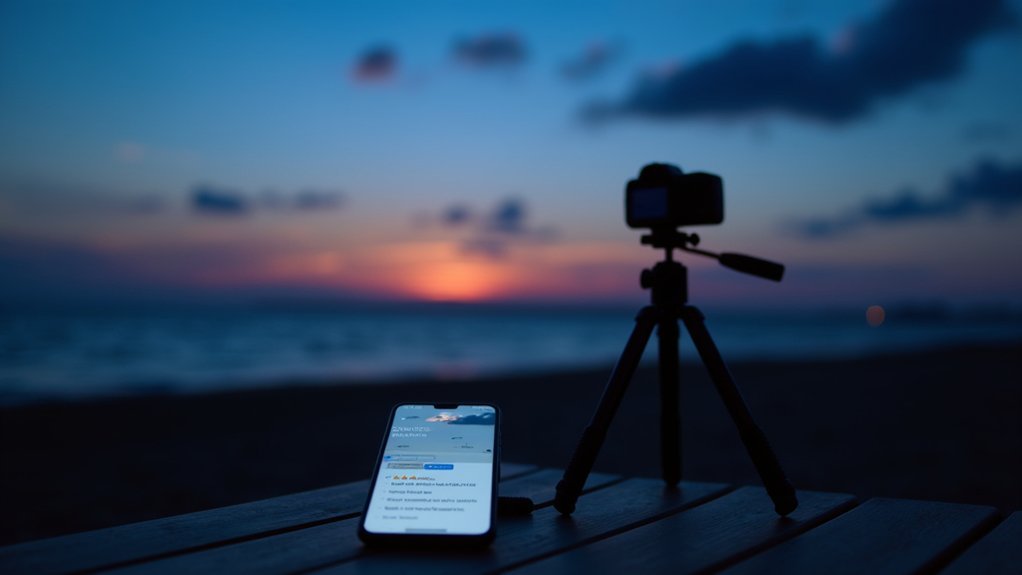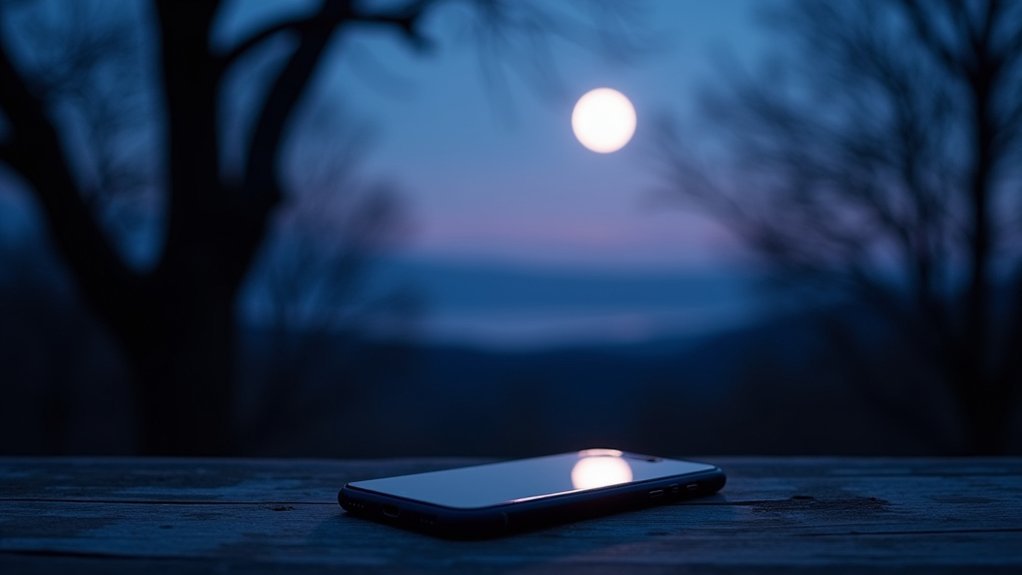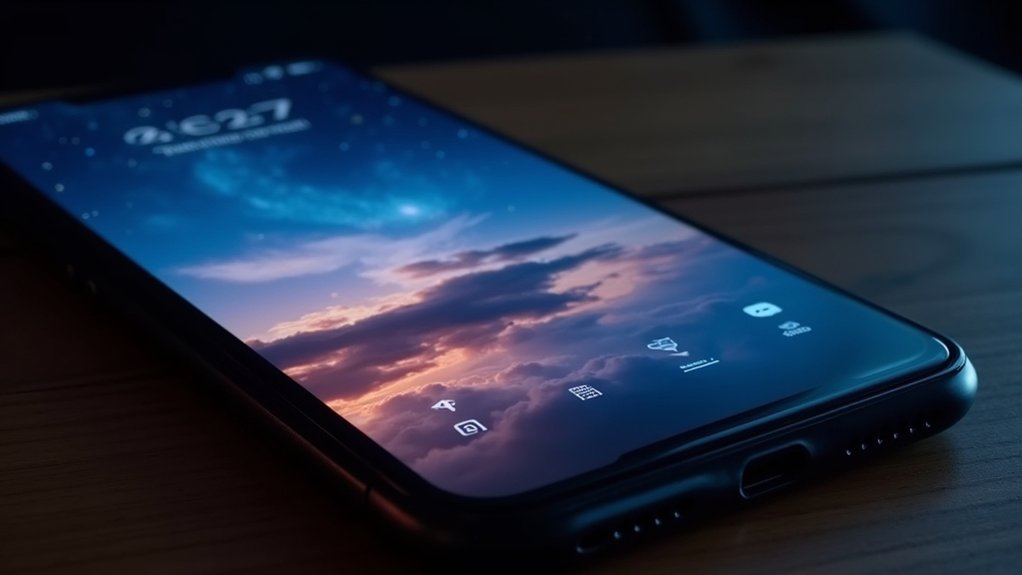Your smartphone transforms into a complete lunar observatory tonight, offering real-time moon tracking, stunning photography capabilities, and weather alerts for ideal viewing. With free apps like Lunar Phase Pro, you’ll access celestial notifications while your phone’s night mode captures impressive moon shots without specialized equipment. Connect with fellow enthusiasts through social media groups sharing live sky conditions. A few simple battery-saving techniques will keep your astronomical companion powered through the entire celestial experience.
Download These Free Lunar Tracking Apps
While stargazing traditionally required almanacs and telescopes, your smartphone now serves as the perfect companion for celestial observation.
Lunar tracking apps like “Lunar Phase Pro” and “Moon Calendar” deliver real-time updates on the moon’s cycle, enhancing your gardening, fishing, or stargazing experiences.
Follow the moon’s rhythm in real-time, transforming your outdoor hobbies with lunar intelligence at your fingertips.
These apps feature interactive sky maps that pinpoint the moon’s position, making it easier to locate throughout the night. You can customize notifications for full moons, eclipses, and other significant lunar events so you’ll never miss an important celestial occurrence.
Many apps also include educational content about lunar science and mythology, deepening your understanding of Earth’s natural satellite.
Best of all, they’re available for both iOS and Android, ensuring you’re just a download away from exploring the night sky.
Setting Up Your Phone Camera for Night Photography
Now that you’ve equipped your phone with the best lunar tracking apps, it’s time to capture those celestial wonders with your camera. Your smartphone is capable of impressive night photography with the right setup.
- Activate your phone’s night mode feature to take advantage of longer exposure times and smart algorithms that enhance low-light captures.
- Find a stable surface or bring a small tripod to eliminate camera shake during longer exposures—this is critical for sharp night images.
- Experiment with higher ISO settings to increase light sensitivity, but be careful not to go too high and introduce grainy noise into your shots.
- Switch to manual focus when shooting distant objects like the moon or stars, as autofocus often struggles in darkness and can ruin your perfect moment.
Moon Phase Calendar Features at Your Fingertips

Your smartphone’s moon phase calendar puts essential lunar information at your fingertips, showing you when the next full moon will illuminate your night hike or when a new moon offers ideal stargazing conditions.
These apps visualize lunar cycles with intuitive interfaces that track the moon’s journey through its waxing and waning phases, making astronomical knowledge accessible even to beginners.
Beyond just moon phases, your phone can predict best night sky viewing times, alerting you to celestial events like meteor showers or when planets will be most visible in your area.
Moon Phase Calendar Features at Your Fingertips
Ever wondered how the moon might affect your evening plans? With moon phase calendar apps, you’ll have celestial insights right in your pocket.
These tools offer real-time lunar cycle tracking with visually stunning graphics that make astronomy accessible.
- Instant phase identification – See exactly what the moon looks like tonight with accurate, animated representations
- Customizable notifications – Set alerts for full moons, new moons, and rare lunar events so you never miss a spectacular sky show
- Historical and future data – Plan activities like gardening or fishing based on lunar influences weeks in advance
- Seamless integration – Connect with your existing calendar and weather apps for a thorough view of how the moon affects your environment and activities
Lunar Cycles Visualized
Looking at the moon through your phone screen transforms abstract lunar data into enchanting visual stories.
Modern smartphone apps offer interactive moon phase calendars that display the entire 29.5-day lunar cycle with stunning graphics that change in real-time.
You’ll see each phase—from new moon to full moon and back again—represented with precision and beauty. These visualizations help you understand how the moon’s position affects everything from tides to gardening schedules and fishing conditions.
Many apps also highlight special events like supermoons and eclipses with animated previews, giving you a front-row seat to celestial performances.
The visual representations make complex astronomical concepts accessible, turning the ancient practice of moon-watching into an engaging digital experience you can carry in your pocket.
Night Sky Predictions
While traditional stargazers once relied on almanacs and weather forecasts, today’s moon phase calendars transform your phone into a personal astronomical assistant.
These apps leverage GPS technology to deliver customized stargazing guidance based precisely on where you stand.
- Real-time moon phase tracking allows you to plan ideal wildlife viewing times when nocturnal creatures are most active.
- Personalized celestial event alerts guarantee you’ll never miss another meteor shower or lunar eclipse.
- Augmented reality overlays that map constellations directly onto your view of the night sky.
- Location-specific predictions that account for your exact coordinates, providing accuracy traditional almanacs simply couldn’t match.
With these tools literally at your fingertips, your smartphone transforms tonight’s sky into a navigable map of astronomical wonders waiting to be discovered.
Using Weather Alerts to Plan Perfect Shooting Nights

How often have you rushed out for a night photography session only to find cloudy skies ruining your plans? Your smartphone’s weather alert apps can prevent these disappointments by delivering real-time atmospheric updates right to your pocket.
Set up location-based alerts to receive notifications about changing conditions at your specific shooting spot. These timely updates on temperature, precipitation, and wind speed enable you to plan with confidence.
Location-specific alerts deliver crucial data directly to your device, empowering photographers to anticipate conditions before arriving on scene.
Use the radar and satellite imagery features to check cloud cover and visibility before heading out.
Don’t overlook moon phase tracking capabilities, which are invaluable for night photography. Different lunar phases dramatically affect lighting conditions for both starscapes and landscape shots.
With these tools at your fingertips, you’ll maximize your chances of capturing that perfect night sky moment.
Capturing Different Moon Phases With Smartphone Settings
Despite what you might believe, your smartphone can capture stunning images of the moon in its various phases without requiring expensive camera equipment. The key lies in optimizing your phone’s settings and using a few simple accessories.
- Activate your phone’s night mode feature to enhance visibility of lunar details and reduce noise in low-light conditions.
- Manually adjust exposure settings downward to prevent the moon from appearing as a featureless white blob.
- Stabilize your device with a tripod to eliminate camera shake during longer exposures.
- Consider adding a clip-on telephoto lens to magnify the moon’s features.
After shooting, use editing apps to fine-tune contrast and brightness, making craters and maria more visible.
With these techniques, you’ll capture moon phases that rival professional photography.
Moonrise and Moonset Notifications You Need

Now that you’ve mastered capturing the moon’s beauty, timing is everything for perfect lunar photography. Setting up moonrise notifications on your smartphone guarantees you’ll never miss that golden moment when the moon first appears on the horizon.
Most weather and astronomy apps offer real-time moon phase updates tailored to your exact location. These notifications don’t just tell you when the moon will appear—they provide details about its position, brightness, and visibility conditions.
For serious lunar enthusiasts, customize your alerts to include reminders for upcoming celestial events like full moons and meteor showers. Some advanced apps even feature augmented reality tools that visualize the moon’s trajectory across your night sky.
With these smart notifications, you’ll transform from casual observer to prepared lunar photographer in no time.
Virtual Scouting for Composition With Map Applications
Why venture into unfamiliar territory when you’ve got powerful scouting tools right in your pocket?
Map applications transform your phone into a virtual scouting assistant, helping you plan perfect nighttime photography compositions before leaving home.
With these tools at your fingertips, you can:
- Explore potential shooting locations using satellite imagery and street view to assess composition options.
- Mark and save promising spots to create an efficient shooting route for the night.
- Discover nearby points of interest like scenic viewpoints and landmarks you might otherwise miss.
- Download offline map functionality to guarantee navigation access in remote areas with poor reception.
Virtual scouting eliminates wasted time and helps you arrive prepared, knowing exactly where to set up for that perfect moonrise shot you’ve been planning.
Social Media Groups for Real-Time Sky Conditions

While your map apps plot the perfect shooting locations, the sky itself remains unpredictable.
That’s where social media groups dedicated to real-time sky conditions become invaluable. Joining these communities on Facebook or Reddit connects you with fellow enthusiasts who regularly post weather changes and celestial events happening right now.
You’ll find members sharing tagged location updates and photos of current conditions, helping you decide if it’s worth heading out tonight.
When someone spots a meteor shower or unusual cloud formation, they’ll alert the group immediately. Have a question about visibility in your area? Post it and receive answers within minutes.
These groups transform your phone into a collaborative weather station, ensuring you won’t miss remarkable sky moments whenever they appear.
Battery Preservation Techniques for All-Night Sessions
When your celestial photography session stretches into the wee hours, maintaining battery life becomes essential for capturing those perfect night sky moments. Your phone can last through the night with these strategic power-saving techniques.
- Dim your screen brightness to the lowest comfortable level – this single adjustment considerably extends battery life during nighttime viewing.
- Enable battery saver mode to restrict background processes and reduce performance demands when you don’t need full processing power.
- Close unused apps that silently drain power even when you’re not actively using them.
- Switch to dark mode if you have an OLED screen, as dark pixels consume less energy than bright ones.
Remember to disable location services and Bluetooth when not needed for additional power savings.
Processing Moon Photos Directly on Your Device
Three powerful editing tools now reside in your pocket, transforming raw moon shots into gallery-worthy celestial portraits without ever leaving your phone.
Your device’s advanced camera technology enables capturing the moon in stunning detail when you utilize manual settings like ISO and shutter speed adjustments.
Unlock your phone’s full lunar potential through manual camera controls for NASA-worthy moon photography.
After capturing your shot, specialized photo editing apps like Snapseed and Lightroom offer astrophotography-specific tools to enhance clarity, contrast, and detail.
Take advantage of your phone’s HDR and RAW capabilities to preserve the moon’s subtle features before editing.
For truly exceptional results, dedicated astrophotography apps such as NightCap provide real-time moon tracking and ideal shooting recommendations.
These apps help you frame the perfect shot and then process it directly on your device, ensuring you’ll capture breathtaking lunar imagery without expensive camera equipment.
Sharing Your Lunar Images Instantly With Photography Communities
You’ll find dedicated lunar photography apps like PhotoPills and NightCap that connect you directly to communities where composition secrets are freely shared among enthusiasts.
After posting your moon shots with tags like #LunarPhotography on Instagram or Flickr, you’ll quickly receive technical feedback from fellow photographers to improve your next capture.
These instant exchanges not only refine your techniques but also introduce you to a network of night sky enthusiasts who continually inspire each other’s work.
Lunar Community Apps
Capturing breathtaking lunar images is only half the journey; sharing them with fellow moon enthusiasts completes the experience.
Lunar community apps connect you instantly with photographers who share your celestial passion, transforming your lunar photography from a solitary pursuit into a collaborative adventure.
These specialized platforms offer:
- Advanced editing tools designed specifically for lunar images, helping you enhance details and contrast before sharing
- Community engagement through challenges and themed events that motivate skill improvement
- Real-time feedback from fellow photographers to refine your techniques
- Educational resources about lunar phases and upcoming celestial events
You’ll find yourself not only improving your photography skills but also becoming part of a vibrant community that celebrates each magnificent moon phase together.
Composition Secrets Revealed
While technical features make lunar photography possible, it’s masterful composition that transforms your moon shots from mere snapshots into breathtaking artwork worth sharing.
Frame your lunar subject using negative space to create visual impact, and experiment with foreground elements like trees or buildings for scale and interest.
After capturing that perfect shot, mobile photography apps let you instantly enhance brightness, contrast, and sharpness to reveal hidden lunar details.
Share experiences with fellow enthusiasts by posting your edited masterpieces directly to platforms like Instagram or Flickr, where photography communities enthusiastically await your contributions.
Don’t forget to use relevant hashtags to connect with lunar photography enthusiasts globally.
During special events like eclipses, you’ll find real-time feedback and appreciation as you document each magical phase from your smartphone.
Instant Feedback Exchange
Once you’ve captured that perfect lunar shot, the digital universe offers boundless opportunities to share your celestial masterpiece. Your smartphone isn’t just a camera—it’s your ticket to immediate connection with photography communities worldwide.
Upload your lunar images and watch as feedback rolls in from fellow enthusiasts who understand the challenges of night photography:
- Use photography apps with built-in editing tools to enhance your lunar details before sharing.
- Join dedicated platforms like Flickr or Instagram where lunar photography hashtags connect you with niche audiences.
- Participate in themed photography challenges to increase visibility and engagement.
- Embrace constructive critiques to refine your technique for your next moon-shooting session.
This instant feedback loop transforms solitary stargazing into a collaborative experience, helping you improve with each celestial event.
Frequently Asked Questions
Why Do I Feel Like I Always Need to Be on My Phone?
You’re likely feeling addicted to your phone because of dopamine hits from notifications, FOMO, and apps designed to keep you engaged. Your brain’s been conditioned to seek this constant digital stimulation and validation.
Why Am I so Addicted to My Phone Lately?
You’re likely addicted to your phone because apps are designed to trigger dopamine releases and form habits. Your brain’s now wired to crave these quick rewards, especially when you’re bored or anxious.
Why Is My Phone so Important to Me?
Your phone’s become central to your identity because it’s your gateway to connection, learning, and productivity. You’ve integrated it into your daily routines, making it essential for managing relationships and accessing information instantly.
Why Do I Feel Happier Without My Phone?
You feel happier without your phone because you’re more present in real moments, engaging in face-to-face connections, and avoiding anxiety triggers. Your mind gets a break from constant stimulation, improving your sleep and mental well-being.
In Summary
You’ve got everything you need right in your pocket for amazing lunar photography. With the right apps, camera settings, and community connections, your phone transforms into a powerful astronomy tool. Don’t wait for expensive equipment—start tracking, shooting, and sharing your moon shots tonight. The universe is literally at your fingertips, and you’re just one tap away from capturing its magic.





Leave a Reply